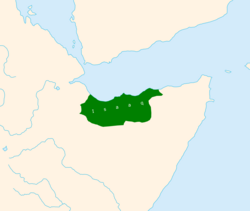
Back سلطنة الإسحاق Arabic ইসহাক সালতানাত Bengali/Bangla Sultanato de Isaac Spanish سلطنت اسحاق Persian Sultanat d'Isaaq French Kesultanan Isaaq ID Sultanato di Isaaq Italian Султанат Исак Macedonian Isimtooyada Isaaq Somali Isaaqsultanatet Swedish
Isaaq Sultanate | |||||||||
|---|---|---|---|---|---|---|---|---|---|
| 1749–1884 | |||||||||
|
A banner used by the Adal Sultanate and later the Isaaq on key religious shrines[1] | |||||||||
 Extent of the Isaaq clan-family at the end of the 19th century | |||||||||
| Capital | Toon (first)[2] Hargeisa (last) | ||||||||
| Common languages | Arabic | ||||||||
| Religion | Sunni Islam | ||||||||
| Government | Monarchy | ||||||||
| Sultan | |||||||||
• ~1700s | Abdi Isse (Traditional Chief) | ||||||||
• 1750–1808 (first Sultan) | Guled Abdi | ||||||||
• 1870–1884 (last) | Deria Hassan | ||||||||
| History | |||||||||
• Established | 1749 | ||||||||
• Disestablished | 1884 | ||||||||
| |||||||||
| Today part of | Somaliland Ethiopia | ||||||||
The Isaaq Sultanate (Somali: Saldanadda Isaaq, Wadaad: سَلْدَنَدْدَ إساقْ, Arabic: السلطنة الإسحاقية) was a Muslim sultanate that ruled parts of the Horn of Africa in the 18th and 19th centuries.[3][4][5][6] The kingdom spanned the territories of the Isaaq clan in modern-day Somaliland and Ethiopia. It was governed by the Rer Guled branch of the Garhajis clan[3] and is the pre-colonial predecessor to the Republic of Somaliland.[7][8][9]
- ^ أل شيخ عبدلله ري اشأل صومالي, كشف السدول لريراش ,٥٠
- ^ The Transactions of the Bombay Geographical Society 1850, Volume 9, p.133
- ^ a b "Somali Traditional States". www.worldstatesmen.org. Retrieved 2023-03-17.
- ^ Ylönen, Aleksi Ylönen (28 December 2023). The Horn Engaging the Gulf Economic Diplomacy and Statecraft in Regional Relations. Bloomsbury. p. 113. ISBN 9780755635191.
- ^ Arafat, S. M. Yasir (2024). Suicidal Behavior in Muslim Majority Countries: Epidemiology, Risk Factors, and Prevention. Springer Nature. pp. 273–274. ISBN 978-981-97-2519-9.
- ^ Sabry, Fouad (2024-08-10). City State: Exploring Urban Governance in Modern Societies. One Billion Knowledgeable.
- ^ "Taariikhda Beerta Suldaan Cabdilaahi ee Hargeysa | Somalidiasporanews.com". Retrieved 2021-01-09.
- ^ Genealogies of the Somal. Eyre and Spottiswoode (London). 1896.
- ^ "Taariikhda Saldanada Reer Guuleed Ee Somaliland.Abwaan:Ibraahim-rashiid Cismaan Guure (aboor). | Togdheer News Network". Archived from the original on 2021-01-11. Retrieved 2021-08-09.
